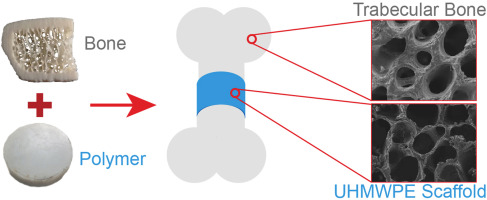Polymer Degradation and Stability ( IF 6.3 ) Pub Date : 2020-01-08 , DOI: 10.1016/j.polymdegradstab.2020.109076 Inna Bulygina , Fedor Senatov , Rajan Choudhary , Evgeniy Kolesnikov , Sergey Kaloshkin , Ronja Scholz , Marina Knyazeva , Frank Walther , Natalya Anisimova , Mikhail Kiselevskiy

|
This study proposes the method of ultra-high molecular weight polyethylene (UHMWPE) biomimetic scaffold fabrication. Anisotropy is considered to be a distinctive feature of native bone but basically only a 3D-fabricated scaffold structure may be anisotropic, while 3D-printing is not applicable to UHMWPE. We proposed a novel method that suggested a template of native mammalian bone to be used as a negative for UHMWPE scaffold fabrication. This method allows direct replication of the bone's structural features on the micro- and macro-scale. Bone scaffolds obtained using the specified method showed anisotropic structure; the pores' average proportions for scaffold and bone were 770 and 470, and 700 and 500 μm, respectively. According to SEM and CT investigations, the scaffolds' macro- and microstructure mimicked the native bone architecture; this feature distinguishes the proposed method from the other UHMWPE scaffold fabrication techniques. The combination of the hydrophilic surface and the nanorelief affected the adhesion and proliferation of cells: the adhesion of multipotent mesenchymal stromal cells (MMSC) amounted to 40% after 4 h; the proliferation of MMSC was 75% after 48 h. The proposed novel method of fabricating biomimetic scaffolds can be used to obtain bone implants of the complex microstructure and anisotropy from high-melt viscosity polymers which cannot be 3D-printed to be further applied in bone reconstruction. The FT-IR analysis confirmed the occurrence of carboxyl oxidation when the surface of UHMWPE sample was treated with chromic acid. The oxidation index (OI) of the samples was found in the order of etching in chromic acid > sterilization > hot moulding respectively. It can be suggested that the oxidative degradation of UHMWPE can be reduced by optimizing manufacturing conditions and further selection of an appropriate processing method.
中文翻译:

用哺乳动物小梁骨模板制作的仿生支架
这项研究提出了超高分子量聚乙烯(UHMWPE)仿生支架的制造方法。各向异性被认为是天然骨骼的独特特征,但是基本上只有3D制成的支架结构可以是各向异性的,而3D打印不适用于UHMWPE。我们提出了一种新方法,该方法建议将天然哺乳动物骨的模板用作UHMWPE支架制造的底片。这种方法可以在微观和宏观尺度上直接复制骨骼的结构特征。使用指定方法获得的骨支架显示出各向异性的结构;支架和骨骼的孔隙平均比例分别为770和470,以及700和500μm。根据SEM和CT调查,这些脚手架 宏观和微观结构模仿了原生骨骼结构;此功能将提出的方法与其他UHMWPE支架制造技术区分开来。亲水表面和纳米浮雕的组合影响细胞的粘附和增殖:4 h后多能间充质基质细胞(MMSC)的粘附达到40%。48h后,MMSC的增殖率为75%。拟议的仿生支架制作新方法可用于从无法进行3D打印以进一步应用于骨骼重建的高熔点粘度聚合物中获得具有复杂微观结构和各向异性的骨植入物。FT-IR分析证实了用铬酸处理UHMWPE样品表面时羧基氧化的发生。样品的氧化指数(OI)分别以铬酸>灭菌>热成型的顺序进行蚀刻。可以认为,通过优化制造条件和进一步选择合适的加工方法,可以减少UHMWPE的氧化降解。











































 京公网安备 11010802027423号
京公网安备 11010802027423号